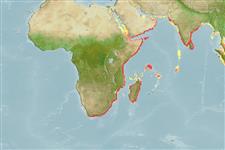>
Eupercaria/misc (Various families in series Eupercaria) >
Haemulidae (Grunts) > Haemulinae
Etymology: Pomadasys: Greek, poma, -atos = cover, operculum + Greek, dasys = with hair (Ref. 45335).
More on author: Day.
Environment: milieu / climate zone / depth range / distribution range
Ecologia
marinhas; estuarina associadas(os) a recifes; intervalo de profundidade 1 - 50 m (Ref. 97537). Tropical; 26°N - 35°S, 14°E - 101°E
Southeast Atlantic: north of Swakopmund, Namibia (Ref. 11228). Indian Ocean: east coast of Africa and Madagascar to Arabia, India and the Malay Peninsula.
Length at first maturity / Tamanho / Peso / Idade
Maturity: Lm 15.0 range ? - ? cm
Max length : 55.0 cm TL macho/indeterminado; (Ref. 2135)
Espinhos dorsais (total): 12; Raios dorsais moles (total): 15-17; Espinhos anais 3; Raios anais moles: 11 - 13. Silver to greenish, darker above; dark blotch on upper opercle; young with yellowish fins, older specimens dusky (Ref. 2799).
Inhabits coastal waters (Ref. 5213). Plentiful in tidal estuaries (Ref. 2135). Stomach contents of specimens collected from Iraq composed mainly of mollusks, sponges and tunicates (Ref. 97537). Large shoals of juveniles occur around shallow water reefs where they consume shrimps and other small invertebrates, being themselves eaten by larger fish; larger specimens are found in deeper water where they spawn throughout the year. Used extensively for bait, flesh rather insipid (Ref. 2799).
Life cycle and mating behavior
Maturidade | Reprodução | Desova | Ovos | Fecundidade | Larvas
Oviparous, distinct pairing during breeding (Ref. 205).
Roux, C., 1986. Pomadasyidae. p. 327-330. In J. Daget, J.-P. Gosse and D.F.E. Thys van den Audenaerde (eds.) Check-list of the freshwater fishes of Africa (CLOFFA). ISNB, Brussels; MRAC, Tervuren; and ORSTOM, Paris. Vol. 2. (Ref. 2135)
Categoria na Lista Vermelha da IUCN (Ref. 130435)
Ameaça para o homem
Harmless
Utilização humana
Pescarias: espécies comerciais; isco: usually
Mais informação
ReferênciasAquaculturaPerfil para aquaculturaEstirpesGenéticaElectrophoresesHereditariedadeDoençasProcessamentoNutrientsMass conversion
ColaboradoresFotografiasStamps, Coins Misc.SonsCiguateraVelocidadeTipo de nataçãoÁrea branquialOutras referênciasCérebrosVisão
Ferramentas
Relatórios especiais
Descarregue XML
Fontes da internet
Estimates based on models
Preferred temperature (Ref.
123201): 23.8 - 28.6, mean 27 °C (based on 176 cells).
Phylogenetic diversity index (Ref.
82804): PD
50 = 0.5000 [Uniqueness, from 0.5 = low to 2.0 = high].
Bayesian length-weight: a=0.01479 (0.00745 - 0.02937), b=2.98 (2.82 - 3.14), in cm total length, based on LWR estimates for this species & Genus-body shape (Ref.
93245).
Nível Trófico (Ref.
69278): 2.6 ±0.14 se; based on food items.
Resiliência (Ref.
120179): Médio, tempo mínimo de duplicação da população 1,4 - 4,4 anos (Preliminary K or Fecundity.).
Fishing Vulnerability (Ref.
59153): Moderate vulnerability (42 of 100).
Nutrients (Ref.
124155): Calcium = 33.1 [12.5, 69.1] mg/100g; Iron = 0.554 [0.283, 0.974] mg/100g; Protein = 19.2 [17.3, 21.0] %; Omega3 = 0.122 [0.065, 0.205] g/100g; Selenium = 34.7 [19.0, 62.9] μg/100g; VitaminA = 57.7 [19.7, 167.1] μg/100g; Zinc = 1.54 [1.05, 2.26] mg/100g (wet weight);
